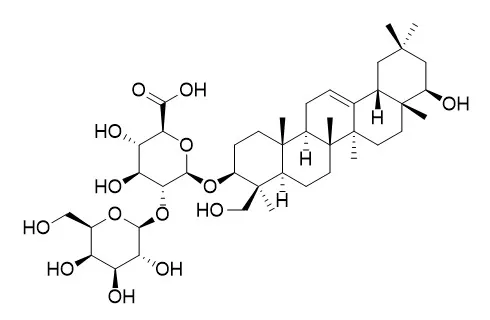| In vitro: |
| Planta Med . 2000 Aug;66(6):506-510. | | Effects of triterpenoids from Pueraria lobata on immunohemolysis: beta-D-glucuronic acid plays an active role in anticomplementary activity in vitro[Pubmed: 10985074] | | The anticomplementary properties of kaikasaponin III (4) and soyasaponin I (8) from Pueraria lobata and their hydrolytic analogs were investigated in vitro. Diglycosidic saponins [kaikasaponin I (3), Soyasaponin III (7)] showed most potent anticomplementary activities, followed by monoglycosidic saponins [soyasapogenol B monoglucuronide (6), sophoradiol monoglucuronide (2)] and triglycosidic saponins [soyasaponin I (8), kaikasaponin III (4)], whereas sophoradiol (1) and soyasapogenol B (5) showed enhancement of hemolysis under the presence of serum on the classical pathway of complement system. But all of them showed very weak or no anticomplementary activities on the alternative pathway of complement system. The anticomplementary activity of the saponins was influenced by the nature of glucuronic acid, where the free acid forms (-COOH) showed much more potent activity than the sodium salt forms (-COO-Na+) or methyl ester forms (-COOCH3), and the reduced forms (-CH2OH) decreased the activity significantly. | | Planta Med . 1998 Apr;64(3):233-236. | | Structure-hepatoprotective relationships study of soyasaponins I-IV having soyasapogenol B as aglycone[Pubmed: 9581521] | | As a part of our study on the leguminous plants, we investigated the constituents of the aerial parts of Glycine soya. We isolated and identified four known saponins, soyasaponins I, II, III, and IV which have the same aglycone, soyasapogenol B. As a part of our studies concerning hepatoprotective drugs, we also examined the hepatoprotective actions of these saponins towards immunologically induced liver injury on primary cultured rat hepatocytes. The action of soyasaponin II was almost comparable with that of soyasaponin I, whereas those of Soyasaponin III and IV were more effective than soyasaponins I and II. This means that the disaccharide group shows greater action than the trisaccharide group. Furthermore, the saponin having a hexosyl unit shows a slightly greater action than that of the pentosyl unit in each disaccharide group or trisaccharide group. Structure-activity relationships suggest that the sugar moiety linked at C-3 may play an important role in hepatoprotective actions of soybean saponins. |
|
| In vivo: |
| Vaccine . 2003 May 16;21(17-18):2145-2151. | | Relationship between adjuvant activity and amphipathic structure of soyasaponins[Pubmed: 12706705] | | A correlation between adjuvant activity and amphipathic structure of saponin was first demonstrated on an experimental basis using structurally consecutive analogues. To clarify the physicochemical factors regulating the adjuvanticity of saponin, we compared the profile of the antibody response against chicken ovalbumin (OVA) in mice and hydrophile-lipophile balance (HLB) of eight purified soyasaponins. Soyasaponins bearing sugar chain(s) showed adjuvanticity stimulating anti-OVA total-IgG and IgG1 antibody responses, while their corresponding aglycones soyasapogenols A and B, did not. Among bisdesmosidic soyasaponins, soyasaponin A(1) (HLB: 26.9) with a long sugar side chain induced stronger total-IgG and IgG1 antibody responses than soyasaponin A(2) (HLB: 21.4). For monodesmosidic soyasaponins, the ranking in terms of antibody response was soyasaponin I (which has the highest HLB value (13.6) among the monodesmosidic soyasaponins) > soyasaponin II (HLB: 12.2) > Soyasaponin III (HLB: 10.0). The adjuvant activity increased with the HLB value. The length, the number, and the composition of sugar side chains affecting the HLB value would give the overall conformation of each saponin molecule, and the amphipathic structure may define the fundamental adjuvanticity of saponins. |
|






 Cell. 2018 Jan 11;172(1-2):249-261.e12. doi: 10.1016/j.cell.2017.12.019.IF=36.216(2019)
Cell. 2018 Jan 11;172(1-2):249-261.e12. doi: 10.1016/j.cell.2017.12.019.IF=36.216(2019) Cell Metab. 2020 Mar 3;31(3):534-548.e5. doi: 10.1016/j.cmet.2020.01.002.IF=22.415(2019)
Cell Metab. 2020 Mar 3;31(3):534-548.e5. doi: 10.1016/j.cmet.2020.01.002.IF=22.415(2019) Mol Cell. 2017 Nov 16;68(4):673-685.e6. doi: 10.1016/j.molcel.2017.10.022.IF=14.548(2019)
Mol Cell. 2017 Nov 16;68(4):673-685.e6. doi: 10.1016/j.molcel.2017.10.022.IF=14.548(2019)